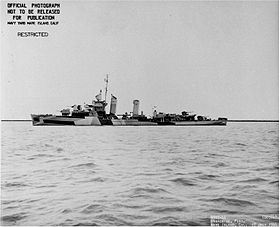Dunlap class
| Dunlap class | |
|---|---|
 USS Dunlap (DD-384) |
|
| Overview | |
| Type | destroyer |
| units | 2 built, 0 in service |
| Namesake | Robert H. Dunlap |
| 1. Period of service |
|
| period of service |
US Navy: 1937-1947 |
| Technical specifications | |
| Information applies to the type ship, later construction lots showed deviations | |
| displacement |
1500 ts |
| length |
341 ft 4 in (104.10 m) |
| width |
34 ft 8 in (10.70 m) |
| Draft |
17 ft (5.30 m) |
| crew |
8 officers, 150 men. |
| drive |
4 boilers, 2 steam turbines , 2 shafts , 50,000 hp |
| speed |
35 kn (65 km / h) |
| Range |
6100 nautical miles at 15 knots |
| Armament |
1940
|
The Dunlap-class was part of the United States Navy's destroyer forces before and during World War II .
A total of two ships were built ( USS Dunlap (DD-384) and USS Fanning (DD-385)), which were originally intended to be part of the Mahan class , but because of the all-too-serious changes, they were converted into a separate “Dunlap class “, Were included.
The difference to the Mahan class consisted in the closed turrets (of the five planned ones, however, only the two front ones could be erected because there were delivery difficulties), instead of the tripod mast behind the bridge, a pole mast was used, the rear mast was omitted, the bulwark up to to the rear chimney and the engine power was increased by 2,000 hp to 50,000 hp. The two ships were equipped with the high-pressure superheated steam turbines newly developed by General Electric with a higher speed than the Parsons turbines previously used .
The increase in combat value of the Mahan-class in 1944 gave these units the approximate appearance of the ships of the Dunlap-class.
The guns were positioned in a line, the two in front in enclosed towers, the other three in open mountings. This made it necessary to protect the rearmost gun (Gun Z) against the muzzle pressure of the gun above it (Gun Y) by means of a deflector plate. Initially, only a set of four torpedo tubes was planned to be installed on the roof of the deckhouse between the chimneys. Then, however, the number of torpedo tubes was increased to a total of twelve in three sets of four. This meant that the two additional sets of pipes had to be placed on the deck behind the aft chimney. In this position, however, they were very close to the surface of the water, which made handling considerably more difficult in heavy seas and which attempts were made to prevent by raising the bulwark.
Armament up to modernization
- 5 × 5 "/ L38 (12.7 cm) guns M12 in two turrets and three M21 mounts. Guns No. 51 and No. 52 on the forecastle, one gun on the deckhouse behind the funnel (No. 53 - this could not be used in the longitudinal direction), as well as the two rear guns No. 54 and 55
- 4 × 12.7mm M2 Browning machine guns, two on a platform in front and below the bridge and two on the deckhouse in front of Gun No. 54
- 12 × 21 "torpedo tubes (3 × 4).
- 2 × water bombs -Abrollgestelle at the stern.
modernization
The artillery and anti-aircraft defenses were changed as early as 1942. A 12.7-cm gun and the 12.7-mm machine guns were eliminated, but eight 20-mm machine guns were on board.
In 1943, both ships were upgraded again.
- Equipped with location and fire control radar "Mk 33 Gun Fire Control System"
- Equipment with radar antenna "Mk 4 o"
- additional installation of 40 mm Bofors anti-aircraft guns
Armament
- 2 × 5 "/ L38 (12.7 cm) guns M12 in turrets
- 2 × 5 "/ L38 (12.7 cm) M12 guns in M21 mounts.
- 4 × (2 × 2) Bofors 40mm anti-aircraft guns
- 5 × Oerlikon 20 mm machine cannons.
- 8 x M15 21 "(53.3 cm) torpedo tubes.
- 2 × depth charges at the stern.
- 4 × K-gun depth charge launchers on port and starboard at gun number 53 level
literature
- Stefan Terzibaschitsch : Destroyer of the US Navy. ISBN 3-86047-587-8 .